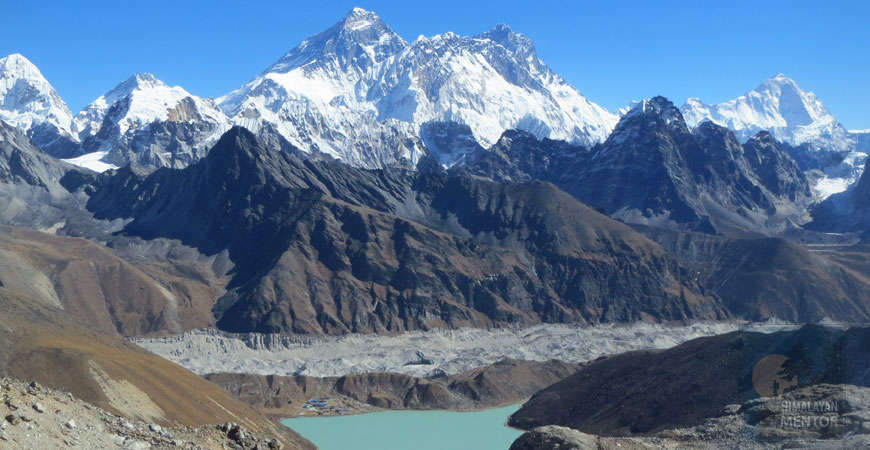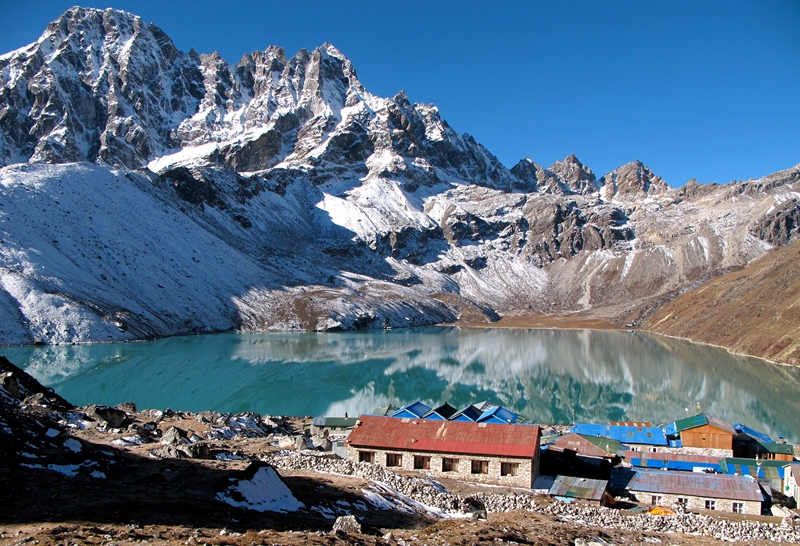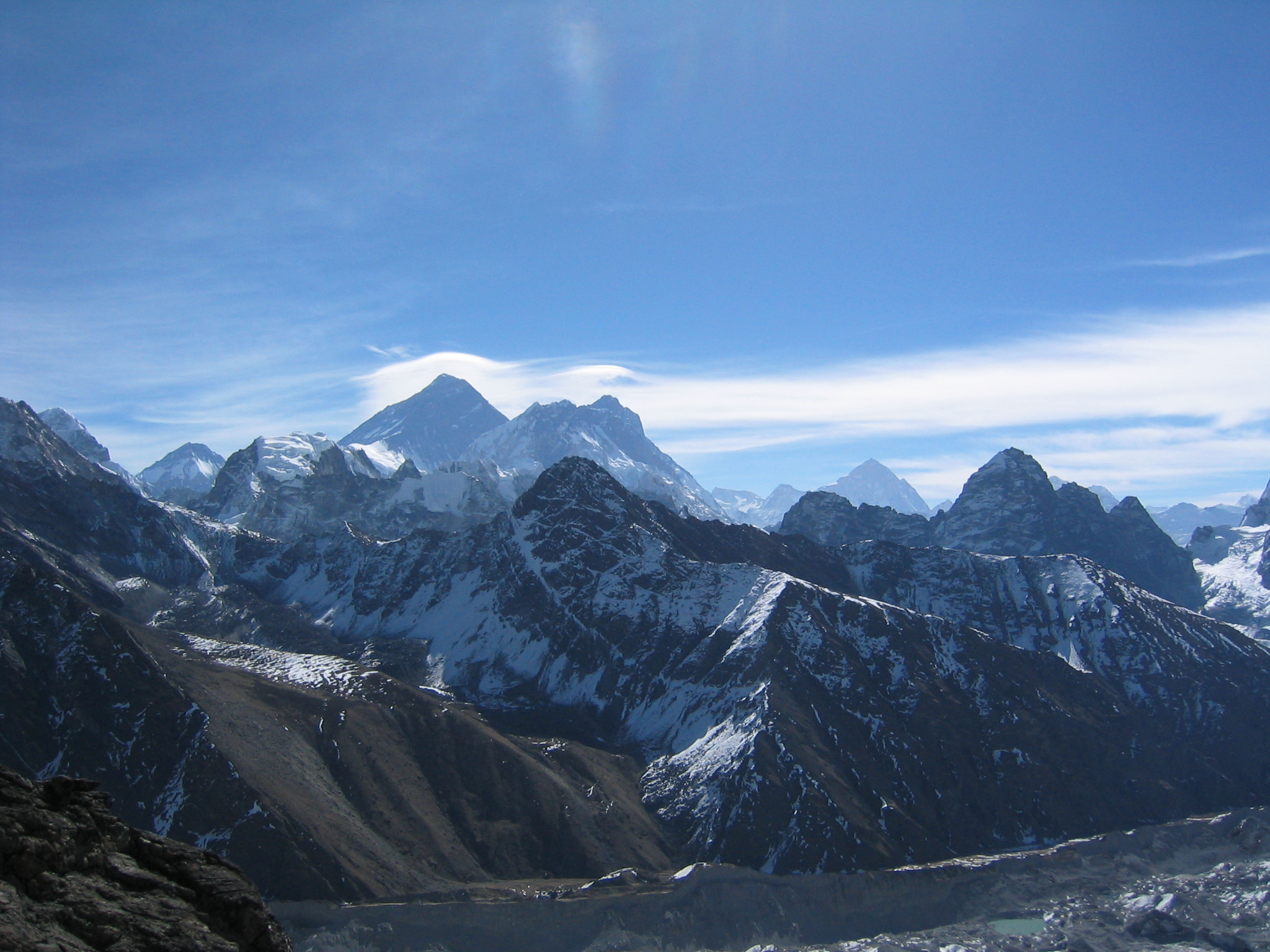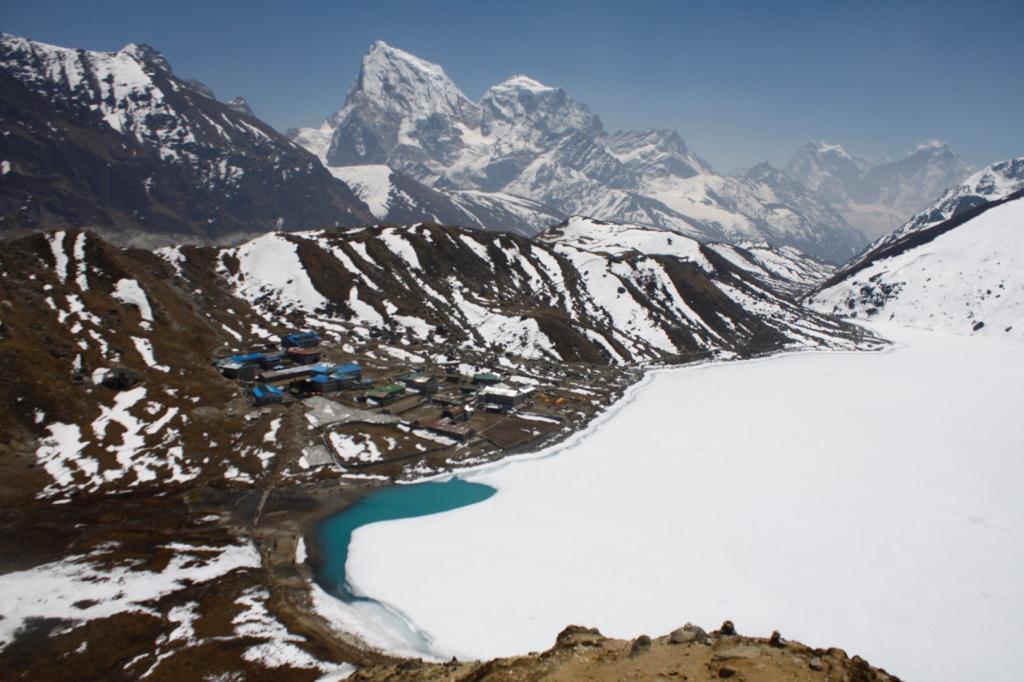|
Gokyo lake and Everest Base Camp Trek is a unique combination of Everest from near and far. Everest the world’s highest mountains never fail to impress. The Gokyo lake and Everest Base Camp Trek take you high into the Himalaya’s presents four of the world’s highest peaks, including Everest, Lhotse, Cho Oyu and Makalu. This trek takes you off the well beaten Everest trail or some unique views of Mount Everest. We have adding in one extra day of critical acclimatization which will help you go higher and stay safer going to altitude, so you will have 3 nights in Namche Bazaar on the way up the trail. Check out our Information page. Gokyo lake and Everest Base Camp TrekMaking the journey through the Everest Region is a visual array of majestic mountains. Our Gokyo lake and Everest Base Camp Trek has a better acclimatization schedule. You can enjoy going to altitude and uncover amazing cultural diversity and the most genuine people you will ever encounter. Read our Top 10 Tips for a safe and successful journey into the Everest region of Nepal. Read about our training advice. |
|||
 |
 |
||
 |
 |
||
A little bit more about the Gokyo lake and Everest Base Camp TrekThe Gokyo lake and Everest Base Camp Trek will underline your trekking career. The Gokyo lake and Everest Base Camp Trek is a unique experience of Everest and this Himalayan region. Seeing Everest from a distances gives perspective, then seeing Everest from close up gives you a unique perspective viewing the highest point on the plant. We like to do this trek in April, May, Late September, October and November.The quickest route into the region is by air, leaving from Kathmandu on a forty-five minute flight into the village of Lukla, which sits at 2,853m/ 9,360 feet. The Everest Region, also known as the Solukhumbu Region, is characterized with sweeping glaciers, picturesque mountains and forests, inhabited by a wide range of animal and bird species as well as world famous monasteries. The Sherpa people dwell in this region, living along the trails, welcoming you to their villages as you move up the valley towards Mt. Everest. Recent statistics show that an extra day in Namche Bazaar gives you the best chance at making the journey to Everest Base Camp. So on some selected treks we will spend three nights acclimatizing in Namche Bazaar giving you the best chance at making the Everest hike to Base Camp. Our Gokyo lake and Everest Base Camp Trek is by no means an easy task. With our expertise and experience, we will provide you with all the necessary information you need to make your trip a success. We will make sure that you are prepared both physically and mentally as well as to make sure that you have trained with and bring the necessary gear and equipment that will make your Gokyo lake and Everest Base Camp Trek is a pleasurable and successful adventure. We have amazing group rates and free group spaces. CONTACT US. |
|||
 |
 |
 |
 |
 |
 |
 |
 |
| On the second day of your journey you enter Sagarmatha National Park, which holds one of the most scenic vista’s in the world, with magnificent views of Mt. Everest, Lhotse, Ama Dablam, and Thamserku, to name a few. You will also venture through Sherpa villages like Khumjung village and spend 3 nights in Namche Bazaar, sampling the wonderful hospitality of these genuine people have to offer. While you are in the Everest region why not consider climbing a 6,000m peak. Prices start from $2,950 | |||
What people said“A challenging, amazing life changing experience for me. The journey, team and experience were all really special. The support for Ian’s team was first class and loved every moment of the trip. I really wanted to do something different in the Everest region and the Gokyo lake and Everest Base Camp Trek was the one for me. Less people the Gokyo lakes region was really special for me. I was blown away with the view off Gokyo Ri.”
Denise Frank, Gokyo lake and Everest Base Camp Trek 2012
We are just back from our Gokyo lake and Everest Base Camp Trek, we had the journey to remember. I wish I had of trekked here many years ago. I trekked to Annapurna base camp with Ian’s team in 2012 and really wanted to visit the Everest region. Ian I want to thank you for another excellently run trip. Your resources were right on. Everyone looked after us so well and this trip exceeded our expectations. Thanks again.
Roger Marshall, Gokyo lake and Everest Base Camp Trek 2013
|
|||
Day 1Fly to Kathmandu, Some people may choose to fly in a day early to have an extra day in Kathmandu enjoying this paced city and help after the earthquake. You should aim to arrive on the afternoon, the day before the trek. There are plenty of sights to visit and explore and you can pick up any last minute items on the streets of the Thamel district. Two nights accommodation in Kathmandu is included in the cost of the trip. One night before and one night afterwards. Day 2Fly from Kathmandu to Lukla. We will make an early morning start for the Twin Otter flight to Lukla (2,853m/ 9,360ft), the gateway to the Khumbu Region. This is an exciting flight, which should give a glimpse of Everest in the distance. In Lukla, we will meet our trek staff, porters or yak herders and set off straightaway for our first night’s stop at Phakding (2,600m/8,500ft). Or continue on to Monjo 2,850/ 9,350ft. Situated on the banks of the Dudh Kosi, which drains the whole of the Khumbu Region, this small hamlet is on the main trade route through the area and there are a number of clean, well-built lodges where we can spend the night. If we trek to Phakding it will take 3 hours. If we trek to Monjo it will take 5 hours. Day 3Trek to Namche Bazaar. We will continue up the banks of the Dudh Kosi, crossing it twice by small suspension bridges before reaching the village of Monjo where we will enter the Sagarmatha National Park. We will then cross the confluence of the Dudh Kosi and the Bhote Kosi on a high suspension bridge and climb steeply for about two hours up ‘Namche Hill’ to reach Namche Bazaar (3,440m/11,286ft). This is a prosperous trading town and the capital of the Khumbu Region. Many Tibetans cross the nearby border to trade their wares here, and the local market is a fascinating spectacle. This is a good place to buy genuine Tibetan artifacts. Just across the valley to the east stand the peaks of Thamserku and Kangtega, both very impressive mountains. We will trek for 4/6 hours today. Day 4We will spent the day in and around Namche. We will make a hike up to Sherpa museum and Everest view point at 3,600m/ 11,811 feet. This will be vital in giving you the best acclimatization for moving further up into the Everest region and help you safely reach the higher altitudes up the trail. We will spend the afternoon resting and relaxing and enjoy a nice chicken sizzler at the lodge. You must keep well hydrated drinking 4 to 5 liters of water per day. 1 hour of trekking today. In the afternoon you can relax around Namche and enjoy cafe Danfe or one of the Namche bakeries. 1 hour of trekking today. Day 5Today will be used as an additional acclimatization day as we need to adjust to the low oxygen levels. We will take a hike up to Shangbouche hill 3,900m/ 12,800ft with stunning panoramic views of the whole Everest Region. During this critical acclimatization phase, we will spend time resting and trekking to higher altitudes to aid in the process. This will allow our bodies to become acclimatized to the altitude of 3,440m/ 11,286ft. After this breath taking hike we will returning to Namche for lunch. The afternoon can be spent resting or walking around the unique village of Namche Bazaar. Day 6After three nights in Namche we move off the main Everest trail and move to Dole at 4,110 m/ 13,152 ft. We climb steeply out of Namche Bazzar up to Khumjung Village. From Khumjung, we can enjoy outstanding views of Thamserku, Kantenga, and Ama Dablam. Most strenuous ascent of the day is pass the Mong La, a very enchanting place nested on the spur of Mt. Khumbila. An ancient historical Chorten stands at the center of the settlement of Mong La. We stop at the top of Mong La to admire the grandest views of surrounding snow-capped mountains and valleys while having lunch. While on the way it will not be unusual to spot wild life, like pheasants, mountain goats, and the evasive musk deer. Traversing through forests, some water falls and bridges, we reach at Dole, a small place with a few teahouses. We will be trekking for 6/7 hours trekking today. Day 7Today we move from Dole to Machherma at 4,470m/ 14,663 ft. We start the day with a steady climb up through a scenic ridge above Dole and the trail climbs via Lhabarma at 4220m/ 13,845ft. to Luza at 4360m/ 14,304ft. The path is steep in most places as we pass through thorny bushes up to Lhabarma. Offering us good views of Cho Oyu, the world’s 6th highest mountain. You will also see Kantega, and Thamserku the trail takes us through many summer settlements and a charming hamlet of Luza 4360m/ 14,304ft. The pace will be slow and you need to keep well hydrated and do not over exert on the trail. Altitude sickness is real and you need to take your time. While ascending from Luza, the Dudh Koshi valley is deep like a canyon with its sheer sides. Walking along the hill side above thundering Dudkoshi passing through some small hamlets and through sandy spurs, we reach Machherma. Machherma is the last major settlement on the way up to Gokyo. The beautiful stream flowing down from the Kyajo Ri and Phari Lapche mountains runs through the middle of village before draining into the Dudh Koshi. It is the place where Khumbu people got first sighting of Yeti in 1974. At this juncture, we can make a visit to the Himalayan Rescue Hospital for a lecture regarding the altitude sickness, its precaution and primary treatment. Overnight at Machherma. We will be trekking for 4/5 hours today. Day 8Machherma to Gokyo 4,800m/15,744 ft. Early on today’s trail we will see fabulous views of both down the valley and of the Mt. Kangtega, Thamserku, and northern part to the Cho-Oyu 8,201m/ 26,906ft. The valley widens as the trail reaches Pangka 4,480m/ 14,698ft. after some gentle walk. Phangka is the palace where an avalanche in 1995 killed 40 people. We descend to the river bank before beginning to climb up to the terminal moraine of the Ngozamba Glacier. It is a steep climb on the moraine. After crossing an iron bridge over an stream the trial levels out as it follows the valley past the first lake, known as Longpongo at 4,690m/ 15,387ft. where we get chance to observe the Lama footprints on a stone. At the sight of the second lake, Taboche Tsho we become enchanted by the sparkling turquoise blue sheet of water sparkling in the sun. Little ahead of the second lake, we reach the third lake, the two linked by a surging stream. Gokyo village stands by the third lake and Cho-Oyu mountain as a backdrop sets an amazing spectacular sight at this junction. After lunch, we explore around the third Lakes, Dudh Pokhari. We spend night at a teahouse with comfortable bedrooms. 4/5 hours of trekking today. Day 9Gokyo Valley Acclimatization Day: We will have an optional hike up to the 5th and 6th Lakes. Today is full day rest or an acclimatization day but we know we should not stay idle. If the weather is good, we grasp the opportunity to climb Gokyo Ri today instead of next day to enjoy the scene from one of the best viewpoint of the Everest Region. The view across Nepal and stunning peaks and magical lakes are work the effort. About 3 km north of Gokyo situates the fourth lake with its high cliffs and peaks rising above it. The trail continues to fifth lake. If interested, we climb on a hill at the edge of the Lakes to get astounding views of Cho-Oyu, Gyachung Kang, Everest, Lhotse, Nuptse, and Makulu. We can see a lot more from here – the spot is called Scoundrel’s Viewpoint. Beyond the fifth Lakes, we will be at Cho Oyu Base Camp. Scenery here is breathtaking with Cho Oyu and Gyachung Kang seeming just a stone’s throw away. The northern part of the fifth lake provides fabulous views of Cho-Oyu Base Camp and biggest glacier of the world- the Ngazumpa glacier. Moved by the charm, we may even try to go sixth lake too but depends upon our own interest and time before heading back to Gokyo village. Day 10Hike up Gokyo Ri 5,357 m/17,570 ft. then head to Thaknak 4,750 m/15,580 ft. If we have not climbed Gokyo Ri the day before we trek there today. Gokyo Ri is the highlight of this trip. Early morning, we hike up to the Gokyo Ri (Gokyo Peak). Climbing to Gokyo Ri is strenuous as it is steep up and takes about 3 to 4 hours to reach the top. The trail vista of Gokyo village on the edge of third lake overlooked by Cholatse and the broad Nogzumpa Glacier are astonishing. We feel like we are surrounded by panoramic mountains like Kusum Kanguru, Thamserku, K43, Kangtega, Taboche, Cholatse, Makalu, Lhotse, Nuptse, Everest, Changtse, and Pumori. Watching the sun bounce off Everest that towers over all surrounding peaks. Your visit to Gokyo Ri will be unforgettable. After being inspired by the highest mountains in the world we trek down to Gokyo. After a well earned breakfast we trek to Thaknak for overnight scaling by the second Lakes and the Ngozumba Glacier. 4/5 hours trekking today. Day 11Thaknak over the Cho-la Pass 5,367m/ 17,604 ft. to Dzongla 4,830m/ 15,939 ft. Crossing the Cho La Pass is very challenging and not to be under estimated. Today is the toughest day pf the trek and we need to start early at 4-6am compared to other days on the trip. The pass is not itself difficult but it is steep and involves a glacier traverse on the eastern side. We need to be careful as the trail is steep and the rocks glazed by ice making this tricky for inexperienced trekkers. The trail from Phedi climbs through a ravine and a rocky trail as we climb up continuously. While trekking through the side of a frozen lake we reach at the top of the pass decorated with prayer flags. Ama Dablam commands the skyline over a range of mountains on the south even as Cholatse soar on the west and Lobuche East and Baruntse rises sharply to our right. We need to pass through some crevasses before we reach Dzongla, another beautiful place with a complete view of Cholatse, Ama Dablam, Lobuche peak and the Pheriche village far below. We will overnight at a very basic local lodge. 7/8 hours of trekking today. Day 12Dzongla to Lobuche 4,920m/ 16,142ft. Today’s hike will be a bit shorter. Thus, we would get more time to observe and relax. We move down from Dzongla and cross a bridge onto a grassy trail. Enjoying the view of Lobuche Peak we stretch up eventually through a ridge. Ama Dablam, Kangtega, Thamserku Taboche are seen looming prominently. Curving round through the wide gravelly river bed, we will arrive in Lobuche, a small hamlet of lodges where we will spend the night. 2/3 hours trekking today. Day 13Lobuche to Gorak Shep 5,170m/16,961ft. and onto Everest Base Camp 5,364 m/ 17,594 ft. and back to Gorak Shep. Once you leave Lobuche the trail is a gradual for about 20 minutes. You then make your way up a short hill call Thangma Riju where we will see amazing panoramic views of the whole Khumbu Glacier. We then move onto the glacial moraine. We will be walking parallel to the Khumbu, Everest glacier. Ahead on the trail we see crest of north ridge of Everest along with Pumori and Nuptse. Climbing steeply up to the top through the torrent of Changri Glacier, we catch our first glimpse of Kala Patthar, a black mount beneath Pumori. As we reach Gorak Shep, we will find snow-capped mountains looming all around us including the top of the world – Mt. Everest. After a brief lunch and rest, we take the trail to Everest Base Camp through the once vast Gorak Shep Lake. Continuing straight ahead, we move across boulders, and move up and down across the Glacial moraine. This can be challenging for some people. Only upon reaching the Everest Base Camp do we really appreciate the Everest climbers who brave the hazardous route through the Khumbu icefall. In April and May Mountaineer’s tents stand out in bright colors against the black and white world of Everest base camp. Mt. Everest is not visible from base camp and we have to wait for the special view. You have made it and after relishing your moment at Everest base camp we trek two hours back to Gorak Shep for our overnight stay. We will be trekking for 8/9 hours today. Day 14Gorak Shep up Kala Patthar and back to Pheriche 4,280m/ 14,070ft. Today is the climax of our trip. We start early in the morning to catch the dramatic views from Kala Patthar witnessing the first light of day shining on Mount Everest. However, we need to get prepared for an early morning, dark and cold temperatures of (-8 to -15 C) There is always the potential for chilly wind which is quite common. As the light appears behind Mt. Everest. Everest slowly begins to reveal itself emerging from the darkness into light. During the ascent to Kala Patthar, we can pause to catch our breath at several outstanding view points to snap pictures. After 3 hours of ascent, we reach Kala Patthar 5,545/ 18,192ft. The last section up to the top is on big boulders is marked by cairns and prayer flags. You can sit on the top of Kala Patthar where Everest will leave you inspired. You can take pictures before making the journey back to Gorak Shep. You will have breakfast and wait other participants to return back. You will pack your bag and after breakfast you will start walking back down to Lobuche and stop in Thukla for lunch and finally make your way back to Pheriche for the night. 8/9 hours trekking today. Day 15Pheriche to Namche Bazzar 3,440m/ 11,280 ft. Today is a long walk down to the lower altitudes, with a few hills thrown in. You will pass through the beautiful Sherpa villages Shomare, Pangbouche and continue down hill passing Ama Dablam on your left. We will cross the river, watching out for landslide region on your left. We will move fast through the forest to Debuche and back up hill to Tengbouche. We might take a quick visit to the Monastery. After having hot drink and snacks at Tengboche, we continuing down the hillside blanketed by rhododendron and juniper trees. If it is spring, the surroundings will be found adored by pink and red rhododendron flowers is dazzling. After walking down hill for 1 hour, we reach our lunch spot by the Dudh Koshi River. After lunch we have a 2 hour up hill hike and then an additional 1 hour high traverse back into Namche Bazaar. Don’t forget to take a last look back to Lhotse, Everest and Tengboche. You will be back at the Himalayan Lodge for a nice hot shower and chicken Sizzler and possibly a drink to two at Cafe Danfe! Day 16Namche Bazaar – Lukla: The trail descends steeply downward so we need to walk slowly and under control as our shaky legs continuously battle the rocky terrain. After crossing the high suspension bridge over the fast flowing Dudh Koshi and its tributaries the trail becomes more level and natural. The temperatures will have warmed up and can be quite warm in May and October. Any remaining sore throats and colds will be gone by today as we move into warmer air. Although we are travelling the same route down, we feel completely different views. We snap a mixture of open plains, rhododendron and pine forests, and in the distance snow covered peaks. We walk through the Sherpa villages noticing impressive faith in Buddhism and culture of prayer stones and prayers flag while we walk through the villages. Upon arrival in Lukla, we stretch those sore legs and recall the experiences of the last couple of weeks. We experience the culmination of a fantastic trek on a happy note with everyone back safe and sound with smile on faces! Overnight at Lukla. 7/8 hours trekking today. Day 17You will be up early for your flight Back to Kathmandu. The early morning flight brings us back to Kathmandu. You can rest and relax throughout the day at hotel. If you would like to explore any other areas in Kathmandu, we can make this happen. We will have a farewell group dinner and you will overnight in Kathmandu. Note: Flights to Kathmandu are usually scheduled for morning because of cloud and windy conditions. There can be delays flying so you can be delayed due to bad weather and other reason that are beyond our control. Day 18Your journey in Nepal comes to an end today! You can hit the streets of Kathmandu, do some shopping or sightseeing. You will be dropped back to the airport approximately 3 hours before your scheduled flight. An Ian Taylor Trekking representative will escort you to the airport. |
|||
|
Ready to go?
Does this information excite you to take the next step towards achieving your goals of trekking to the Gokyo lake and Everest Base Camp Trek If so, get in touch today. We pride ourselves on making sure that our clients have every opportunity to succeed in the mountains, including professional training advice, gear lists and video links on how to pack your bag, and much more. We are always available to answer any questions you may have by email, phone or skype, so contact us today! |
|||
 |
|||

